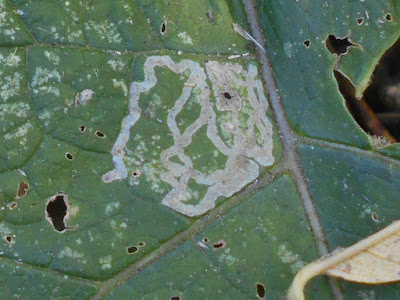The first time I ever went there must have been about twelve years ago and I came away impressed with what seemed a fascinating reserve. After today's visit I left wondering whether I should ever bother again. To be fair, conditions were not at their best: the west of Northamptonshire, together with much of the English Midlands, has endured a long summer with very hot and dry conditions; wildlife has not benefited. The plants were looking dusty and and droopy; it seemed that everything was on hold, with no rain to stimulate any fresh growth. The water level in the pool itself had dropped by at least two feet.
 |
Water level were lower than this photograph suggests. Byfoels Pool,
near Byfield, Northants. 20 September, 2019
|
Inevitably there were features of interest. Swags of Black Bryony, Tamus communis, clambered from branch to branch with clockwise turns, covered with scarlet but poisonous berries. Needle-sharp crystals of calcium oxalate seem to be responsible for the illness caused by consuming them but cases are apparently rare nowadays.
 |
| The scarlet berries of White Bryony are eye-catching. Byfield Pool, 20 September, 2019 |
White Bryony, Bryonia dioica, is - if distribution maps are to be believed - almost equally common and I frequently encountered this member of the Cucumber Family in my childhood, but I have not seen it for a long time. It too has poisonous scarlet berries but the two species are not even distantly related. It was surely White Bryony to which John Clare alluded when he wrote:
The Bryony in the hedge that now adorns
The tree to which it clings and now the thorns
Owns five-starred pointed leaves* of dingy white.
Clare's Rural Muse, 37
Mammals seem to largely avoid both plants but presumably birds eat the fruit.
The Bryony in the hedge that now adorns
The tree to which it clings and now the thorns
Owns five-starred pointed leaves* of dingy white.
Clare's Rural Muse, 37
Mammals seem to largely avoid both plants but presumably birds eat the fruit.
The ground flora around Byfield Pool is depressingly limited, consisting of about 60% Wood Avens, Geum urbanum with most of the remaining plants consisting of nettles. I found a few ferns, one plant of St John's Wort and one of Lesser Burdock, Arctium minus. Of course, there were many other plants present but they were scarce. Sinuous mines on the Burdock were the work of Phytomyza lappae.
 |
Lesser Burdock leaf mined by Phytomyza lappae. Byfield Pool.
20 September, 2019
|
A few plants of Meadowsweet occurred near the entrance. They too had been mined, or more correctly galled, by Dasineura pustulans. Both the Dasineura and the Phytomyza were new records for the site.
 |
Dasineura pustulans has produced these galls on Meadowsweet.
Byfield Pool, 20 September, 2019
|
It was while I stooped to photograph the meadowsweet that another species was recorded. I had put down my sweep-net in order to reach for my camera but within a few seconds a dragonfly had landed on it.
 |
A Ruddy Darter investigates my sweep net. Byfield Pool,
20 September, 2019
|
It was a Ruddy Darter, Sympetrum sanguineum. The Common Darter, S. striolatum is more frequently met but the specimen on my net had a deeper, almost blood-red (hence 'sanguineum') abdomen and completely black legs.
It wasn't the rarest insect I encountered today but, perhaps because dragonflies are not something I often spend time over, it was the most pleasing.
* Sic - but White Bryony has five petals of a dingy greenish-white.
No comments:
Post a Comment